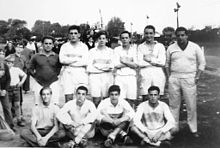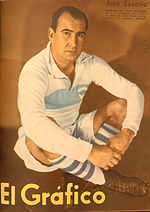Gimnasia y Esgrima de Buenos Aires
 | |
| Full name | Club de Gimnasia y Esgrima de Buenos Aires |
|---|---|
| Founded | 11 November 1880 |
| Ground | Estadio GEBA |
| Location | Buenos Aires |
| League(s) | Metropolitano (Field hockey) |
| Affiliations | Argentine Hockey Confederation |
| Activities | Athletics, Basketball, Basque pelota, Boxing, Chess, Climbing wall, Contract bridge, Fencing, Field hockey, Football, Artistic Gymnastics, Golf, Martial arts, Roller hockey, Roller skating, Rugby union, Swimming, Table tennis, Tennis, Volleyball, Water polo, Yoga |
President | José Beraldi [1] |
| Colors | (White, Light blue) |
| Website | www |
Club de Gimnasia y Esgrima (also known for its acronym GEBA) is an Argentine multi-sports club placed in the city of Buenos Aires. The institution is one of the oldest in the country, having been established in 1880. Gimnasia y Esgrima is also one of largest clubs in the country, where around 30 different disciplines are hosted in the three buildings that the institution owns in Buenos Aires.
History
The institution was founded as "Club Cosmopolita de Gimnasia y Esgrima" on 11 November 1880, by fencing and gymnastics enthusiasts in the "Confitería del Aguila", a traditional coffee house of Buenos Aires. Léon Marchand was designed the first president of the club.
Three years later, in 1883, the club changed its name to "Club de Gimnasia y Esgrima".[1] In 1909 Ricardo Camilo Aldao became president of the institution.[2]

The football team took part in the Primera División championships during the amateur era. After winning the second division championship in 1909,[3] Gimnasia y Esgrima promoted to the top division, where it played from 1910 to 1917 when the team was relegated to the second division after finishing 20th of 21 teams.[4] The club disaffiliated from the Association soon later, although football has remained as one of the sports practised up to present days.
In 1912, Gimnasia y Esgrima was part of the first break up in Argentine football, due to a conflict caused by the position of the club about the sales of tickets for football matches. Gimnasia stated that its members should not pay for tickets because of their membership, which allowed them to take part of all the activities, including free access to the stadium. The club also claimed a higher percentage of the income for tickets sold. The conflict persisted until Gimnasia decided to disaffiliate from the Association on July 14, 1912, establishing a new league, the "Federación Argentina de Fútbol", presided by Ricardo Aldao himself.
Other clubs followed Gimnasia y Esgrima joining the new league, such as Porteño, Estudiantes de La Plata, Independiente, and other teams from the second division. The new league organized its own championships from 1912 to 1915, when both leagues merged into "Asociación Argentina de Football", putting an end to the conflict.[5]


The club's stadium (which has a capacity of 18,000 spectators) was the field where the Argentina national team played its home games since 1910, making its debut during the "Torneo Centenario de la Revolución de Mayo" held there. In the final match of that tournament, played against Uruguay, a riot occurred after the suspension of the match was announced, and part of the grandstands -made of wood- were destroyed by fire. After the stadium was rebuilt, many football games held there, even when Gimnasia had disaffiliated from the Association.[5][6]
After leaving the official football leagues in the decade of 1910, rugby union was one of the predominant sports of Gimnasia y Esgrima, winning the Torneo de la URBA titles of 1911 and 1912. The club won two more titles in 1932 and 1939, its last championship to date. Gimnasia y Esgrima currently plays in the Grupo II, the second division of the Unión de Rugby de Buenos Aires league system.[7]
In 1942 president Aldao moved to the club's distinguished guest apartment, establishing it as its permanent home. The only condition required by Aldao to live there was the payment of a monthly rent which would be the 6% of the investments made by the club when the apartment was built. In 1947 and after 40 years as president of the institution, Aldao resigned due he was afraid of a possible intervenction of the Argentine military government in the club.[2]
Gimnasia has gained a good reputation in women's field hockey due to its successful campaigns during the decade of the 2000, having won 7 Torneo Metropolitano titles, six of them consecutively being the last in 2012.[8][9]
On September 2014, the rugby union senior squad returned to the first division (Grupo I) after defeating Manuel Belgrano by 23-16 at playoffs (Zona Reubicación).[10] The team had been relegated in 2007.[11]
Facilities
The club has three facilities to host the practise of different sports. All of them are located in the city of Buenos Aires.
- Aldao: named in honour of Ricardo Aldao, of the most prominent presidents of the institution, also founder of dissident league "Federación Argentina de Fútbol" in 1912. Aldao also donated the trophy (named "Copa Aldao") for the tournament held from 1913 to 1955 played between Argentine Football Association and Uruguayan Football Association teams. With 35,000 m2, the facility is located on Bartolomé Mitre street of the city of Buenos Aires. The sports practised there are basque pelota, boxing, contract bridge, chess, martial arts, artistic gymnastics and yoga.
- Jorge Newbery: named honoring Argentine aviation pioneer Jorge Newbery, who was also a notable fencer (he won the first South American championship at Gimnasia y Esgrima in 1901), died in 1914. The facility occupies 55,000 m2 on Dorrego Avenue, near to Galileo Galilei planetarium in the Palermo district. Athletics, swimming and water polo are some of the sports hosted there. Here is located the club stadium, where the football and rugby union teams from the club played their home games. The Argentina national rugby union team also played there in the 1970s. The stadium (known in Argentina as "Estadio GEBA") is currently used for concerts.[11]
- San Martín: The biggest facility, with 139,000 m2, on Figueroa Alcorta avenue. Some of the sports practised there are football, roller skating, rugby union, table tennis and volleyball.
Notable athletes

| Athlete | Sport |
|---|---|
| Swimming | |
| Swimming | |
| Rugby union | |
| Field hockey | |
| Rugby union | |
| Field hockey |
Uniforms
Gimnasia y Esgrima's teams have also worn a white jersey with a horizontal light blue band. The most used alternate jersey has been the dark blue model, leaving the horizontal band the same as the original.
Home |
Away |
Honours

Basketball
- Primera División (2): 2006, 2014
Football
Field hockey
- Women's
- Metropolitano de Primera División (8): 1965, 2007, 2008, 2009, 2010, 2011, 2012,[19][20][21] 2013[22][23][24]
Rugby union
- Torneo de la URBA (4): 1911, 1912, 1932, 1939
Music concerts
The club usually rents two of its facilities for concerts and events, being the Jorge Newbery facility the most used for those purposes. Many international artists touring on Argentina have played at Gimnasia y Esgrima, named "Estadio GEBA"-[25]
References
- ^ a b Información institucional on club's official site
- ^ a b "Un ejemplo de dirigente" by Jorge Cermesoni, La Nación, 1998-2-3
- ^ "Campeones de Segunda División" at AFA website
- ^ "1917 Argentina Primera División" at RSSSF
- ^ a b Historia del Fútbol Amateur en la Argentina by Jorge Iwanczuk - Publisher: Autores Editores (1992) - ISBN 9504343848
- ^ "Historia del fútbol en GEBA"
- ^ "Historia de GEBA" at URBA website
- ^ "http://www.ambito.com/noticia.asp?id=662630", Ambito Financiero, 11 November 2012
- ^ "GEBA y el desafío de un grande", La Voz del Interior, 26 March 2010
- ^ "Banco Nación, Los Tilos y GEBA regresaron a Primera", ESPN, 20 Sep 2014
- ^ a b "Gimnasia y Esgrima de Buenos Aires y su historia, a Primera" by Jorge Búsico, La Nación, 25 Sep 2014
- ^ "Martín Naidich clasifició a los Juegos Olímpicos en 1500 libres", TyC Sports, 8 Aug 2015
- ^ "Heroico: Damián Blaum es campeón mundial de aguas abiertas", TN.com, 1 Sep 2013
- ^ "Damián Blaum y un reinado que se hizo esperar", CanchaLlena, 6 Jan 2014
- ^ El Gráfico N° 1105 (1939) - Published by Editorial Atlántica, Buenos Aires
- ^ "Jorge Prezioso: “Creo que no hicimos los puntos que merecíamos”" at Rugbychampagneweb, 6 Jun 2013
- ^ "GEBA, el primer tricampeón de la Liga Nacional de Hockey" at CanchaLlena.com, 12 Sep 2011
- ^ "GEBA sufrió pero zafó del repechaje" at Hockeymobile.com, 20 Oct 2013
- ^ "Historial de los Campeones de Hockey en Argentina", HSRA
- ^ "GEBA, campeón por quinta vez consecutiva" - TyCSports, 20 November 2012
- ^ "Hockey: las chicas de GEBA campeonas por sexta vez consecutiva", DeporteYa.com, 12 November 2012
- ^ "GEBA,heptacampeón" at ESPN
- ^ "GEBAv vence a Belgrano y es campeón por séptimo año consecutivo", El Comercial
- ^ "Hepta campeonas" at club website
- ^ "Estadio GEBA sede Jorge Newbery" on Entradasx.com
External links
- Sports clubs established in 1880
- Football clubs in Buenos Aires
- Argentine field hockey clubs
- Argentine rugby union teams
- Rugby clubs established in 1880
- Multi-sport clubs in Argentina
- 1880 establishments in Argentina
- Football clubs disaffiliated from the Argentine Football Association
- Sports clubs in Buenos Aires
